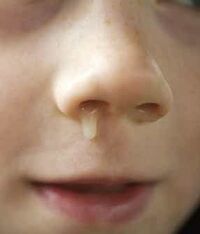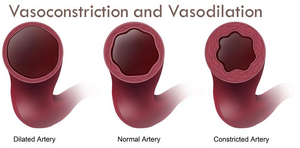Physical alterations
Bodily pressures
Bodily pressures can be described as the physical experience of spontaneous pressures across differing parts of the body. These can occur as static and fixed in their location or they can occur at seemingly random varying points across the body. Depending on the intensity of the sensation, this can result in pressures which range from neutral to extremely uncomfortable in their experience.
Bodily pressures are most commonly induced under the influence of heavy dosages of stimulating psychedelics, such as 2C-E, DPT, and 5-MeO-DMT.
Bronchodilation
Bronchodilation can be described as the expansion of the bronchial air passages in the respiratory tract. A bronchodilator is a substance that dilates the bronchial tubes resulting in decreased resistance in the respiratory airway and increased airflow to the lungs. From a subjective standpoint, this effect makes it feel as if has become significantly easier and more comfortable to breathe.
Bronchodilation is often accompanied by other coinciding effects such as stimulation. It is most commonly induced under the influence of moderate dosages of stimulant compounds, such as amphetamine,[1] methamphetamine, and cocaine,[2]. These compounds were historically used often for treating asthma but are now rarely, if ever, used medically for their bronchodilation effect.
Changes in felt bodily form
Changes in felt bodily form can be described as feelings of the body shifting in its perceived physical shape, organization and form in a manner which is typically devoid of accompanying visual alterations. For example, feelings of the body folding into itself many times over, stretching, splitting into separate parts, expanding, or condensing into, over, and across itself in extremely complex forms are all entirely possible. It is worth noting that although this effect is usually perfectly comfortable to undergo, it can sometimes be somewhat uncomfortable under certain circumstances.
Changes in felt bodily form are often accompanied by other coinciding effects such as perspective hallucinations, perspective distortions, and changes in felt gravity. They are most commonly induced under the influence of heavy dosages of hallucinogenic compounds, such as psychedelics, dissociatives, and Salvinorin A.
Changes in gravity
Changes in felt gravity can be described as feeling that the pull of gravity has shifted in its direction. For example, during this state one may feel as if they are floating forwards, backwards, upwards, downwards, or in an unspecifiable direction.
Changes in felt gravity are often accompanied by other coinciding effects such as geometry, internal hallucinations, and holes, spaces and voids. They are most commonly induced under the influence of heavy dosages of hallucinogenic compounds, such as psychedelics, dissociatives, cannabinoids, and salvinorin A.
Excessive yawning
Excessive yawning can be described as the experience of repeated, intensified, overly frequent, and spontaneous yawning despite a complete absence of genuine sedation or sleepiness.
Excessive yawning is often accompanied by other coinciding effects such as increased salivation and a runny nose. It is most commonly induced under the influence of moderate dosages of tryptamine psychedelic compounds, such as psilocybin, 4-AcO-DMT, 4-HO-MET, and ayahuasca.
Muscle relaxation
Muscle relaxation can be described as the experience of muscles losing their rigidity or tenseness while becoming relaxed and comfortable. This effect is particularly useful for those who are currently suffering from muscle spasms, pain, and hyperreflexia.
Muscle relaxation is often accompanied by other coinciding effects such as sedation and anxiety suppression. It is most commonly induced under the influence of moderate dosages of depressant compounds, such as various benzodiazepines, GABAergics, and opioids. However, it can also occur to a lesser extent under the influence of cannabinoids.
Physical autonomy
Physical autonomy can be described as the experience of a person's own body performing simple or complex actions entirely of its own accord. Depending on the intensity, this results in the carrying out of a given task becoming partially to completely automatic in nature without the requirement of decision-making skills or attentive conscious input.
At lower levels, the effect is partially controllable by commanding the body with simple thoughts. For example, thoughts such as "go to the toilet" or "go drink a glass of water" can result in the body performing these actions autonomously. This can often help the person perform necessary physical actions such as tending to bodily functions or avoiding danger when they would otherwise be too incapable, unconscious, or distractible to perform them manually in their current state.
At higher levels, this effect no longer requires verbal commands and becomes entirely automatic. It's worth noting that although this technically results in a loss of cognitive control, the body only performs actions which the owner would have decided to perform were they capable of it themselves.
Physical autonomy is often accompanied by other coinciding effects such as physical disconnection and cognitive disconnection. It is most commonly induced under the influence of heavy dosages of dissociative compounds, such as ketamine, PCP, and DXM. However, it can also occur to a lesser extent under the influence of heavy dosages of psychedelics such as LSD, psilocybin, and mescaline, as well as cannabinoids such as cannabis.
Physical euphoria
Physical euphoria can be described as feelings of pleasure and comfort within and across the body. This euphoria typically feels somewhat comparable to the endorphin rushes felt during states of excitement or love, the coziness of a comfortable bed, and the rush of an orgasm. The forcefulness of this effect can range from subtle in its strength to overwhelmingly pleasurable beyond even the most intense full body orgasm possible.
Physical euphoria is often accompanied by other coinciding effects such as cognitive euphoria and muscle relaxation. It is most commonly induced under the influence of heavy dosages of a wide variety of compounds, such as opioids, stimulants, and GABAergics. However, it can also occur in a more powerful although less consistent form under the influence of psychedelics and dissociatives.
Pupil constriction
Pupil constriction (also called pinpoint pupils or miosis) can be described as the reduction of the size of a person's pupils under normal lighting conditions. This typically decreases a person's ability to see in low light conditions.
Pupil constriction is most commonly induced under the influence of moderate dosages of opioid compounds, such as heroin, kratom, tramadol, and fentanyl.
Pupil dilation
Pupil dilation (also called mydriasis) can be described as the enlargement of the size of a person's pupils under normal lighting conditions. Normally, the pupil size increases in the dark and shrinks in the light, however, a dilated pupil will remain excessively large even in a bright environment.
Pupil dilation is most commonly induced under the influence of moderate dosages of a wide variety of serotonergic compounds, such as psychedelics, dissociatives, deliriants, entactogens, various stimulants[3] and some antidepressants.
Runny nose

A runny nose can be described as a condition where the nasal cavity is filled with a significant amount of mucous fluid, otherwise known as "snot". This occurs relatively frequently within healthy human beings and is a common symptom of allergies or certain diseases, such as the common cold or hay fever. It can also be a side effect of crying and exposure to cold temperatures.
A runny nose is often accompanied by other coinciding effects such as excessive yawning, increased salivation, increased phlegm production, and watery eyes. It is most commonly induced under the influence of heavy dosages of tryptamine psychedelic compounds, such as psilocybin, 4-AcO-DMT, and 4-HO-MET. However, it can also occur under the influence of opioid withdrawals[4]) and as a symptom of cocaine abuse.[5]
Skin flushing
Skin flushing can be described as the experience of a sudden reddening of the skin which is usually accompanied by feelings of rushing blood and warm skin. In terms of its appearance, it manifests itself in an identical although more intense fashion to that which occurs across the face when one is embarrassed. Blotchiness or solid patches of redness are also often visible during states of skin flushing.
Skin flushing is most commonly induced under the influence of heavy dosages of opioid compounds, such as heroin, tramadol, fentanyl, and kratom. However, it can also occur under the influence of alcohol, certain psychedelics such as 5-MeO-DMT, and stimulants, such as caffeine.
Sublingual numbing
Mouth numbing is a physical side effect of administering certain drugs sublingually (under the tongue) or buccally (via the cheeks and gum). The effect can be described as a distinct feeling of general numbness or tactile suppression around the tongue and mouth which can last for up to an hour after the drug has been administered.
The NBOMe series (25C-NBOMe, 25B-NBOMe, and 25I-NBOMe) cause this effect consistently and it is accompanied by a strong, unpleasant, metallic chemical taste immediately after sublingual absorption.
The stimulant known as cocaine also causes numbing of the tongue, gums, and mouth when administered sublingually. Many people test the purity of their cocaine by rubbing it in their mouth. This, however, is not a guarantee of the drug's quality as it is common for cocaine to be cut with various other numbing agents and local anesthetics, such as novocaine, lidocaine, or benzocaine, which mimic or add to cocaine's numbing effect.
Spontaneous tactile sensations
Spontaneous tactile sensations are the experience of sensations across the body occurring without any obvious or immediate physical trigger. This results in feelings of seemingly random but distinct tingling sensations that occur across the skin and within the body. Depending on the psychoactive substance consumed, these vary greatly in their styles of sensation. This effect is capable of manifesting itself across the three different levels of intensity described below:
- Mild - At the lowest level, the sensation can be described as subtle and fleeting tingling sensations throughout the body. These sensations do not impair physical motor control and can essentially be ignored if one wishes to do so.
- Distinct - At this level, the sensation becomes very difficult to ignore. It can be described as distinct tingling sensations which are intense enough to partially impair a person’s motor control and act as a significant distraction which impairs one's focus.
- Overwhelming – At the highest level, the tingling sensations increase enough to become a powerful, uncontrollable focus point of the person's attention. This can feel completely overwhelming and heavily impairs a person's motor control, leaving them either lying or sitting down, incapable of standing up due to the all-encompassing sensations.
Spontaneous tactile sensations are often accompanied by other coinciding effects such as tactile intensification and physical euphoria. They are most commonly induced under the influence of moderate dosages of psychedelic compounds, such as LSD, psilocybin, and mescaline. However, they can also occur under the influence of stimulants, cannabinoids, and dissociatives.
Variations
The specific differences between each potential style of spontaneous bodily sensation can be broken down into the following variations:
- Moving vs. Motionless – Spontaneous physical sensations will either move up and down various parts of the body in different directions or they will remain still and consistent in their position.
- Constant vs. Spontaneous – Spontaneous physical sensations will either be constantly present throughout a significant portion of the experience or they will spontaneously and temporarily manifest themselves at random points for differing lengths of time.
- Sharp vs. Soft – Spontaneous physical sensations will either be perceived as sharp, cold, and electric or as soft, warm, and gentle.
- All-encompassing vs. Location specific - Spontaneous physical sensations can either be felt across every square inch of the skin in an evenly distributed fashion or in very specific locations such as the ends of the fingers and toes, up and down the spinal column or throughout the head.
- Euphoric vs. Dysphoric – At appropriately high dosages, spontaneous bodily sensations can either be interpreted as pleasurable to experience or they can manifest in the opposite direction and become uncomfortable to experience.
Tactile hallucinations
A tactile hallucination is the experience of perceiving a convincing physical sensation which is not actually occurring.[6][7] Common examples of this can include people or insects touching the body in various places and in a wide variety of ways. Alternatively, these hallucinations can be felt as complex and structured arrangements of vibration across the skin.
This effect may be also accompanied by visual hallucinations of a plausible cause of the sensation. For example, during internal and external hallucinations one may be able to touch and feel imagined objects or autonomous entities just as convincingly as within normal everyday dreams. The sensations that are possible within these hallucinations are near limitless and can even include pain or sexual pleasure.
Tactile hallucinations are most commonly induced under the influence of heavy dosages of deliriant compounds, such as DPH, datura, and benzydamine. However, they can also occur to a lesser extent under the influence of psychedelics, stimulant psychosis[8] and extreme sleep deprivation.
Levels of hallucination
Note that not all detailed effects are not universal, instead, it gives an overall idea of intensity of effect. Every substance has more or less unique hallucinatory state progression.
- Partial hallucination: An already-existing touching sensation or very warmth of the body might move or have an unexpected details such as warmth and pressure. Effect is still minor and might feel more imagination than actually perceived effect.
- Full hallucination: Effect is clear and indistinguishable from real sensations. It can have any kind of biologically possible details and either replicate realistic ideas but might just as well stay abstract.
- Extended hallucination: With this level on the sensations can mix and blur out with other concepts such as spatial awareness and yield otherworldly experiences. The one could physically sense detailed presence of invisible entities and objects, possess nonexistent or impossible body parts, physically being part of non-self object-entity or one could even experience physical effects from abstract thoughts. (synesthesia)
Variations
While details are given as in two opposite possibilities, the experiences often have details from the both ends.
- All-encompassing vs. Location specific: The sensations can be limited to small areas or be all-body-encompassing.
- Interactive vs. Static: The effect can be intricate to create immersive interaction with entities and objects or have stay as a static plot or even as completely inanimate awareness.
- Clear sensations vs. Mixed sensations: Biologically realistic sensations include temperature, touch, pressure, pain and physical orientation. These often mix over areas and animated forms for confusing combinations, such as electricity.
- Realistic texture vs. Abstract texture: Perceived textures can mimic those of real objects or be completely made up from unique collages of other tactile properties.
- Euphoric vs. Dysphoric: Sensations usually carry out either instantaneous positive or negative feedback.
Visual sliding
Optical sliding can be described as a physical effect which inhibits the coordination and control of a person's eyes by suppressing their ability to keep them still. This results in the eyes continuously moving in a variety of directions combined with the sensation of not being able to stare motionless at any particular point.
The optical condition nystagmus causes sufferers very similar symptoms, although the frequency of movement is generally far greater with nystagmus.
Optical sliding is often accompanied by other coinciding effects such as visual acuity suppression and double vision. It is most commonly induced under the influence of heavy dosages of dissociative compounds, such as ketamine, PCP, and DXM. However, it can also occur to a lesser extent under the influence of extremely heavy dosages GABAergic depressants.
Vasodilation

Vasodilation can be described as a widening of the veins and blood vessels which results from the relaxation of smooth muscle cells within the vessel walls. It is particularly prevalent in the large arteries and small arterioles. The primary function of vasodilation is to increase blood flow in the body to tissues that need it most. In essence, this process is the opposite of vasoconstriction, which is the narrowing of blood vessels.
This effect is typically very difficult to consciously perceive but often results in a bloodshot red eye effect and relief from glaucoma.
Vasodilation is often accompanied by other coinciding effects such as decreased blood pressure. It is most commonly induced under the influence of moderate dosages of cannabinoid compounds, such as cannabis, JWH-018, and THJ-018. However, it can also occur under the influence of poppers and viagra.
Watery eyes

Watery eyes can be described as a physical effect which results in a state of continuous involuntary streaming, tearing, crying, and watering of the tear ducts within one's eyes. The experience of this effect often leads to the feeling that a person is crying for no reason despite a complete absence of the relevant emotions one would usually expect during such a state.
Watery eyes is often accompanied by other coinciding effects such as excessive yawning and a runny nose. It is most commonly induced under the influence of moderate dosages of psychedelic tryptamine compounds, such as psilocybin, 4-AcO-DMT, and 4-HO-MET.
See also
References
- ↑ Lowinson, J. H. (2005). Substance Abuse: A Comprehensive Textbook. Lippincott Williams & Wilkins. ISBN 9780781734745.
- ↑ Streatfeild, D. (July 2003). Cocaine: An Unauthorized Biography. Macmillan. ISBN 9780312422264.
- ↑ Zuba, D. (February 2012). "Identification of cathinones and other active components of 'legal highs' by mass spectrometric methods". TrAC Trends in Analytical Chemistry. 32: 15–30. doi:10.1016/j.trac.2011.09.009. ISSN 0165-9936.
- ↑ Kneisl, C. R., Trigoboff, E. (2004). Contemporary psychiatric-mental health nursing (1st ed.). Pearson. ISBN 9780132557771.
- ↑ Myon, L., Delforge, A., Raoul, G., Ferri, J. (February 2010). "[Palatal necrosis due to cocaine abuse]". Revue De Stomatologie Et De Chirurgie Maxillo-Faciale. 111 (1): 32–35. doi:10.1016/j.stomax.2009.01.009. ISSN 1776-257X.
- ↑ Berrios, G. E. (April 1982). "Tactile hallucinations: conceptual and historical aspects". Journal of Neurology, Neurosurgery, and Psychiatry. 45 (4): 285–293. ISSN 0022-3050.
- ↑ Lewandowski, K. E., DePaola, J., Camsari, G. B., Cohen, B. M., Ongür, D. (May 2009). "Tactile, olfactory, and gustatory hallucinations in psychotic disorders: a descriptive study". Annals of the Academy of Medicine, Singapore. 38 (5): 383–385. ISSN 0304-4602.
- ↑ Morani, A. S., Panwar, V., Grasing, K. (April 2013). "Tactile hallucinations with repetitive movements following low-dose cocaine: implications for cocaine reinforcement and sensitization: case report". The American Journal on Addictions. 22 (2): 181–182. doi:10.1111/j.1521-0391.2013.00336.x. ISSN 1521-0391.